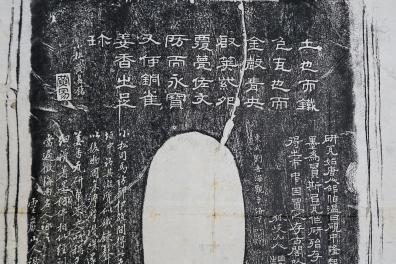Stamping in China: images and inscribed objects" exhibition, March 6-30

From March 6 at 6 pm to March 30 at 8 pm
From 10 am to 10 pm every day except Sunday
Pôle des langues et civilisations - 65 rue des Grands Moulins 75013
Galerie de l'auditorium et Rez-de-jardin de la BULAC
Free admission.
Chinese stamping is a technique for reproducing engraved texts and images, usually on stone, and more rarely bas-reliefs and objects, in ink on paper.
If prints are known as research supports for the historian or philologist, and as sources of models for the calligrapher, this exhibition studies them from another, less explored angle, that of visual and material culture.
The stamp has a value autonomous from the stamped object: it is a work in ink above all, and a collector's item in its own right.
Chinese prints are rarely exhibited in Europe: this is the first attempt to devote an entire exhibition to them, bringing together some forty prints from the EFEO Archives, including eleven original documents, and a dozen prints discovered at the BULAC as part of this project.
The exhibition is organized into thematic sections, beginning with an introduction to the "classical" function of the prints through a few emblematic pieces, then moving on to take a closer look at object prints, figurative representations, and landscapes.
The exhibition has an important didactic dimension, as the notices accompanying the prints were written in collaboration between the organizers and the students, most of whom were able to work directly on the original documents during the year 2022.
Guided tours will be offered by Inalco students and Lia Wei, as well as a printmaking workshop :
- Thursday March 9 at 5pm - visit by students in the presence of one of the organizers (Lia Wei)
- Wednesday March 15 at 3pm - visit by participating students
- Thursday March 16 at 11am - visit by students in the presence of one of the organizers (Lia Wei)
- Wednesday March 22 at 6pm - visit by participating students
- ATELIER CANCELLEDThursday, March 23 at 11am (auditorium foyer) - printmaking workshop with students in the presence of one of the organizers (Lia Wei)
- Thursday, March 30 at 11am - guided tour by students in the presence of one of the organizers (Lia Wei)
. tour by participating students
The exhibition is organized by Lia Wei (Inalco/IFRAE) and Michela Bussotti (EFEO/UMR CCJ), with the participation of Soline Suchet (BULAC) and Dat-Wei Lau (EFEO), as well as a team of bachelor, master and doctoral students from Inalco and EPHE: Francesca Berdin, Eric Bouteiller, Marie Blondin-Dessemme, Killian Cahier, Zack Chasseriaud, Ema Demptos, Anna Le Menach, Killian Miramende, Bastien Roth, Paula Sumera, Yin Tianjie, Yuan Ye.
A study day is organized by IFRAE on the occasion of this exhibition on March 29, 2023.
Chinese stamps from the EFEO Archives, new research approaches
Discover the new EFEO Asian Treasures video. Michela Bussotti (EFEO), Claude Laroque (Paris I Panthéon-Sorbonne) and Lia Wei (Inalco/IFRAE) discuss the exhibition's conception and new research approaches to the Chinese stamping technique.
La pierre et le pinceau
A film by Marie-Françoise Plissart
This film was shot in 2010-2011 in Chongqing, in the provinces of Sichuan and Shandong, and in Beijing.
It shows the stamping process in the field, following Lia Wei and Zhang Qiang in their fieldwork in the rock-cut tombs of the Eastern Han dynasty (2nd to 3rd century CE) and the Buddhist epigraphy of the Northern dynasties (6th century CE).
Partner institutions: BULAC, EFEO, IFRAE, Inalco.